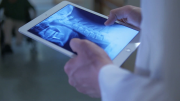There’s an incredible number of new technologies emerging every single day, from smart appliances to mobile phones and everything in between. The world we live in right now is something that science fiction novelists had only dreamed about, but there is one major hurdle we have yet to overcome.
The majority of the new technologies appearing on the market today are designed for abled and neurotypical individuals. Accessibility for people with disabilities is often lacking, especially for those without vision. Why is health tech accessibility a key component for public health?
Places Where Tech Accessibility Is Lacking
For most users, walking into a doctor’s office and filling out new patient paperwork on a digital kiosk might seem like a great convenience. No more worrying about whether the office staff can read your handwriting, or whether they’ll input your information correctly, because you’ve done all the hard work yourself.
That sort of technology, especially in the waiting room of a doctor’s office, is only useful for people who don’t require assistive technology to fill out standard or digital paperwork. A blind or low-vision individual will have to enlist the help of a third party. And in a public space, they may find it difficult to keep their personal information private.
These same digital health records can present a problem if a patient needs to see or review their records. According to HIPAA, patients are allowed to request their health records and can expect to receive them in a timely fashion. For electronic health records, this could mean receiving a digital file or a printed copy, neither of which are particularly accessible.
These are just a few examples of things abled individuals might take for granted because it doesn’t directly impact them or their quality of life. Tracking your health with a smartwatch is great, unless it only offers visual inputs and you’re severely visually impaired.
Public health may not have been on everyone’s mind before 2020 and the COVID-19 pandemic. But it’s something everyone spends time thinking about these days. The Coronavirus Aid, Relief, and Economic Security (CARES) Act is providing $178 billion in relief funds in direct response to the pandemic. While much of this money will be necessary for patient care, how can hospitals and other medical facilities offer accessibility while public health is at the forefront of everyone’s mind?
The Parts of an Effective Public Health Program
A 2014 study found that in order to create a successful public health program, six things are necessary. Each new public health program starts with an innovation — understanding that a problem exists and figuring out the best way to address it. From there, the project moves in four different directions at the same time, with each aspect holding the same level of importance. These include:
- Partnerships: Public health is a complex issue and not something that can generally be tackled by a single entity.
- Management: Implementation of a new public health program is primarily a management concern. Building a functional management team is essential.
- Communication: Effective communication includes medical professionals and civic leaders as well as the public that the health program will be helping or supporting.
- Technical packaging: An evidence-based package the innovators can present to potential supporters to explain what this public health program is supposed to do.
Finally, in order to complete the preparations and create a successful public health program, political and civic commitment and support are necessary. Without cooperation from local, state, and federal legislators, no public health program will be able to get off the ground. There is one thing that is missing from this outline that is necessary for any new public health programs in 2021 and beyond: accessibility.
Designing public health programs to include accessible technologies and techniques should start from the ground up. Collectively, we need to stop thinking of accessibility as things we add as an afterthought and start making the world accessible for everyone. Accessibility isn’t optional. It’s a necessity to ensure people with disabilities have access to everything abled individuals are able to access, without needing to ask for assistance from a third party.
Looking Toward the Future
The lack of health tech accessibility is a widespread problem that won’t be fixed by a few frustrated words on the internet. It will take people who are willing to stand up and make the necessary changes so that at some point in the near future, we won’t have to have conversations about accessibility.
Providing options for people with all levels of ability will be part of the planning and development of every significant step forward, from creating the next tech innovation to managing public health.
Article by Shannon Flynn, Business Technology Writer, ReHack





